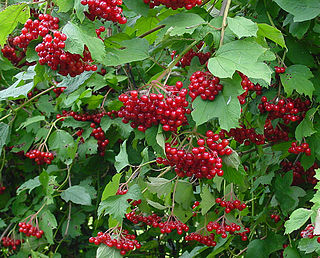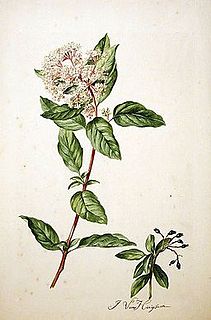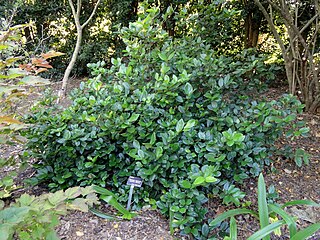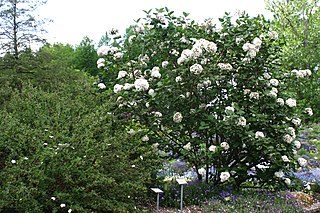Related Research Articles

Viburnum is a genus of about 150–175 species of flowering plants in the moschatel family Adoxaceae. Its current classification is based on molecular phylogeny. It was previously included in the honeysuckle family Caprifoliaceae.

Viburnum lentago, the nannyberry, sheepberry, or sweet viburnum, is a species of Viburnum native to North America.

Viburnum opulus, the guelder-rose or guelder rose is a species of flowering plant in the family Adoxaceae native to Europe, northern Africa and central Asia.

Viburnum tinus, the laurustinus, laurustine or laurestine, is a species of flowering plant in the family Adoxaceae, native to the Mediterranean area of Europe and North Africa. Laurus signifies the leaves' similarities to bay laurel.

Viburnum acerifolium, the mapleleaf viburnum, maple-leaved arrowwood or dockmackie, is a species of Viburnum, native to eastern North America from southwestern Quebec and Ontario south to northern Florida and eastern Texas. It is adapted for USDA hardiness zones of 4 to 8.

Gracillariidae is an important family of insects in the order Lepidoptera and the principal family of leaf miners that includes several economic, horticultural or recently invasive pest species such as the horse-chestnut leaf miner, Cameraria ohridella.

Viburnum plicatum is a species of flowering plant in the family Adoxaceae, native to mainland China, Korea, Japan, and Taiwan. The Latin specific epithet plicatum means “pleated”, referring to the texture of the leaves.
USS Viburnum (AN-57/YN-76) was a Ailanthus-class net laying ship which served with the U.S. Navy in the Pacific Ocean theatre of operations. While operating in the Caroline Islands, she was severely damaged when struck by what appeared to be a Japanese torpedo. However, she continued her work as well as she could, and, when she returned to the United States, she was considered too damaged to repair. She was sold in her damaged condition, and was eventually scrapped.
Phyllonorycter lantanella is a moth of the family Gracillariidae. It is found in all of Europe, except Scandinavia, Ireland and the Balkan Peninsula.
Phyllonorycter viburni is a moth of the family Gracillariidae. It is known from the islands of Honshu, Shikoku and Kyushu in Japan.
Phyllonorycter cinctata is a moth of the family Gracillariidae. It is known from the Nepal.
Phyllonorycter viburnella is a moth of the family Gracillariidae. It is known from Québec in Canada and Connecticut and Ohio in the United States.
Alloclemensia unifasciata is a moth of the family Incurvariidae. It is found in Japan on the islands of Hokkaido, Honshu and Kyushu.

Viburnum suspensum, commonly called Sandankwa viburnum, is a compact, perennial shrub, native to Japan. It grows up to 3.7 m in height.

Viburnum carlesii, the arrowwood or Korean spice viburnum, is a species of flowering plant in the family Adoxaceae, native to Korea and Japan and naturalised in Ohio, USA. Growing to 2 m (7 ft) tall and broad, it is a bushy deciduous shrub with oval leaves which are copper-coloured when young. Round clusters of red buds open to strongly scented, pale pink flowers in late spring. These are followed in late summer by oval red fruits ripening to black in autumn.

Gracillariinae are a subfamily of moths which was described by Henry Tibbats Stainton in 1854.

Viburnum odoratissimum, commonly known as sweet viburnum, is a shrub or small tree in the family Adoxaceae. It is native to Asia, and commonly cultivated as a garden ornamental elsewhere.

Viburnum dilatatum, commonly known as linden arrowwood or linden viburnum, is a deciduous shrub in the moschatel family (Adoxaceae). It is native to eastern Asia, and can be found as an introduced plant in the mid-Atlantic regions in the U.S from New York to Virginia. Linden arrowwood is known for the clusters of red drupes it produces when it is mature.

Viburnum japonicum, the Japanese viburnum, is a species of flowering plant in the family Viburnaceae. It native to Zhejiang in China, Gageodo island in South Korea, the Ryukyu Islands, and Japan. A rounded evergreen bush reaching 6–8 ft (1.8–2.4 m), with glossy leaves and strongly scented flowers, it is hardy to USDA zone 7.

"Hey, Hey, Rise Up!" is a song by the English rock band Pink Floyd, released on streaming and downloading platforms on 8 April 2022. It is based on a 1914 Ukrainian anthem, "Oh, the Red Viburnum in the Meadow", and features vocals in Ukrainian by Andriy Khlyvnyuk of the Ukrainian band BoomBox. The track is the first entirely new piece of music recorded by Pink Floyd since "Louder than Words" was released with The Endless River in 2014. Guitarist David Gilmour was inspired to record it in support of Ukraine during the 2022 Russian invasion. The band both released the track as a single commercially and also put out a music video, directed by Mat Whitecross, centered around images of life struggling amidst warfare. A physical edition of the single on CD and vinyl was released on 15 July 2022, which also included a new version of "A Great Day for Freedom".
References
- 1 2 3 4 Tosio Kumata (August 1963). "Taxonomic studies on the Lithocolletinae of Japan (Lepidoptera : Gracillariidae) Part 2" (PDF). Insecta Matsumurana. 26 (1): 1–48. ISSN 0020-1804. Wikidata Q110229260.